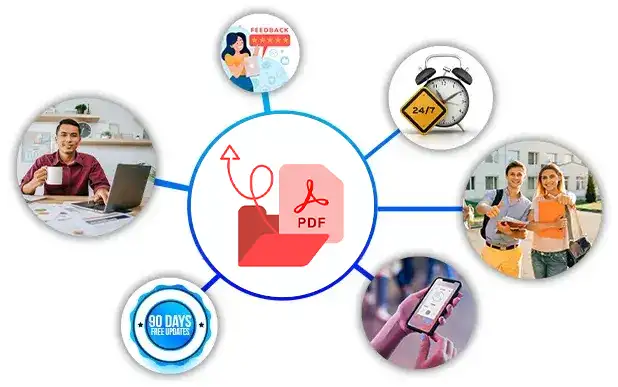Oracle 1Z0-1109-23 PDF Exam Questions:
How to Get Success in Oracle 1Z0-1109-23 Exam:
- Avoid deceptive 1Z0-1109-23 PDF Exam Questions.
- Focus on 1Z0-1109-23 Questions (PDF) based on the latest exam syllabus.
- Make notes of Oracle 1Z0-1109-23 PDF for better learning.
- Prepare from our latest Oracle 1Z0-1109-23 PDF file and get success in first attempt.


Prepare Oracle 1Z0-1109-23 Exam Within Short Time
Your knowledge and abilities are validated by passing the Oracle 1Z0-1109-23 exam. Our PDF questions and answers will help you prepare for the 1Z0-1109-23 exam in a short time because it includes questions similar to the real Oracle exam questions. After downloading the 1Z0-1109-23 Oracle PDF exam questions, relevant to the actual exam, you can take a print of all questions and prepare them anytime, anywhere.
Realistic Scenario Based Oracle 1Z0-1109-23 PDF Exam Questions:
Everyone wants to become certified Oracle Cloud and improve his/her resume. You should practice with real 1Z0-1109-23 questions. Students can benefit from the 1Z0-1109-23 exam questions which are available in PDF format. The 1Z0-1109-23 exam questions and answers are designed to match the criteria of the actual exam. If you use scenario-based Oracle 1Z0-1109-23 questions you will have an extra potential to clear the exam on the first attempt.
A developer is using the Oracle Cloud Infrastructure (OCI) DevOps service to build an application. They are currently in the process of setting up the required infrastructure using the available tools. In which two ways can you explain the difference between Ansible and Terraform? (Choose two.)
See the explanation below.
The two correct explanations for the difference between Ansible and Terraform are: Ansible auto-mates software installation and application deployment, while Terraform manages infrastructure as code. This highlights the primary focus of each tool. Ansible is mainly used for automating tasks related to software installation, application deployment, and configuration management. It is well-suited for managing the software stack and ensuring consistency across systems. On the other hand, Terraform specializes in infrastructure provisioning and management, allowing users to define and manage their infrastructure resources using code. Ansible focuses on infrastructure configuration, while Terraform specializes in infrastructure provisioning. This highlights the different aspects of infrastructure management that each tool addresses. Ansible is designed to handle configuration management tasks, such as setting up software, managing files, and applying configuration changes across systems. It excels at ensuring the desired state of the infrastructure. In contrast, Terraform is focused on provisioning infrastructure resources, such as virtual machines, networks, and storage. It provides a way to define and manage these resources in a declarative manner, allowing for infra-structure as code. It's worth noting that while Ansible is supported and provided by OCI as a con-figuration management tool, Terraform is a third-party tool that has gained popularity for managing infrastructure across multiple cloud providers, including OCI.
You as a DevOps Engineer are asked to manage an application to be deployed in Oracle Cloud Infrastructure Container Engine for Kubernetes (OKE). This requires pulling images from Oracle Cloud Infrastructure Registry (OCIR) during deployment. Which three statements are true? (Choose three.)
You are a developer who has made a mistake when adding variables to your build_spec.yaml file. This mistake resulted in a failed build pipeline. Which is a possible error you could have made?
See the explanation below.
The possible error you could have made when adding variables to your build_spec.yaml file that resulted in a failed build pipeline is assuming that a non-exported variable would be persistent across multiple stages of the build pipeline. In a build pipeline, variables need to be properly exported and managed to ensure their availability and persistence across different stages. If you mistakenly assumed that a non-exported variable would persist across stages, it could lead to issues where the variable is not available or its value is not maintained as expected, causing the build pipeline to fail.
Which two changes to infrastructure with the Oracle Cloud Infrastructure (OCI) Provider for Terraform will NOT result in any resources being destroyed or provisioned? (Choose two.)
See the explanation below.
The two changes to infrastructure with the Oracle Cloud Infrastructure (OCI) Provider for Terraform that will not result in any resources being destroyed or provisioned are: Adding a CIDR block to a VCN: This change does not affect any existing resources. It simply expands the IP ad-dress range of the VCN, allowing for the creation of additional subnets within the VCN. Adding a subnet to a VCN: Similar to adding a CIDR block, adding a subnet to a VCN does not affect any existing resources. It defines a new subnet within the VCN's IP address range, allowing for the al-location of resources to that subnet. Changing the image OCID of a compute instance, changing the shape of a compute instance, and changing the Display Name of a compute instance can potentially result in resource destruction and provisioning. These changes may require the creation of new in-stances, reconfiguration of existing instances, or termination of existing instances, depending on the specifics of the changes.
Which statement is true regarding the Oracle Cloud Infrastructure (OCI) DevOps service?
See the explanation below.
The correct statement is: Users can avoid downtime during deployments and automate the complexity of updating applications. The Oracle Cloud Infrastructure (OCI) DevOps service provides a set of tools and services that help automate and streamline the software development and deployment processes. One of the key benefits of OCI DevOps is the ability to avoid downtime during deployments by implementing strategies such as blue-green deployments or rolling deployments. By using OCI DevOps, users can automate the complexity of updating applications by defining CI/CD (Continuous Integration/Continuous Deployment) pipelines. These pipelines can include steps for building, testing, and deploying applications, allowing for efficient and reliable updates without disrupting the availability of the application. The other statements provided are not accurate: OCI DevOps allows users to migrate workloads from on-premises environments as well as from other cloud plat-forms. Users can store code in both public and private repositories, including internal code repositories. OCI DevOps provides visibility into the full lifecycle phases of applications, allowing users to assess performance and make informed decisions. Reference: https://docs.oracle.com/en-us/iaas/Content/devops/using/devops_overview.htm
Reliable Source Of Preparation For Oracle Cloud Infrastructure 2023 DevOps Professional Exam.
We provide Oracle Cloud certification questions along with answers to assist students in passing the Oracle Exam. You can enhance your Oracle 1Z0-1109-23 preparation with the help of an online practice engine. Try out our Oracle 1Z0-1109-23 questions because 98% of Examskit users passed the final 1Z0-1109-23 exam in one go.
